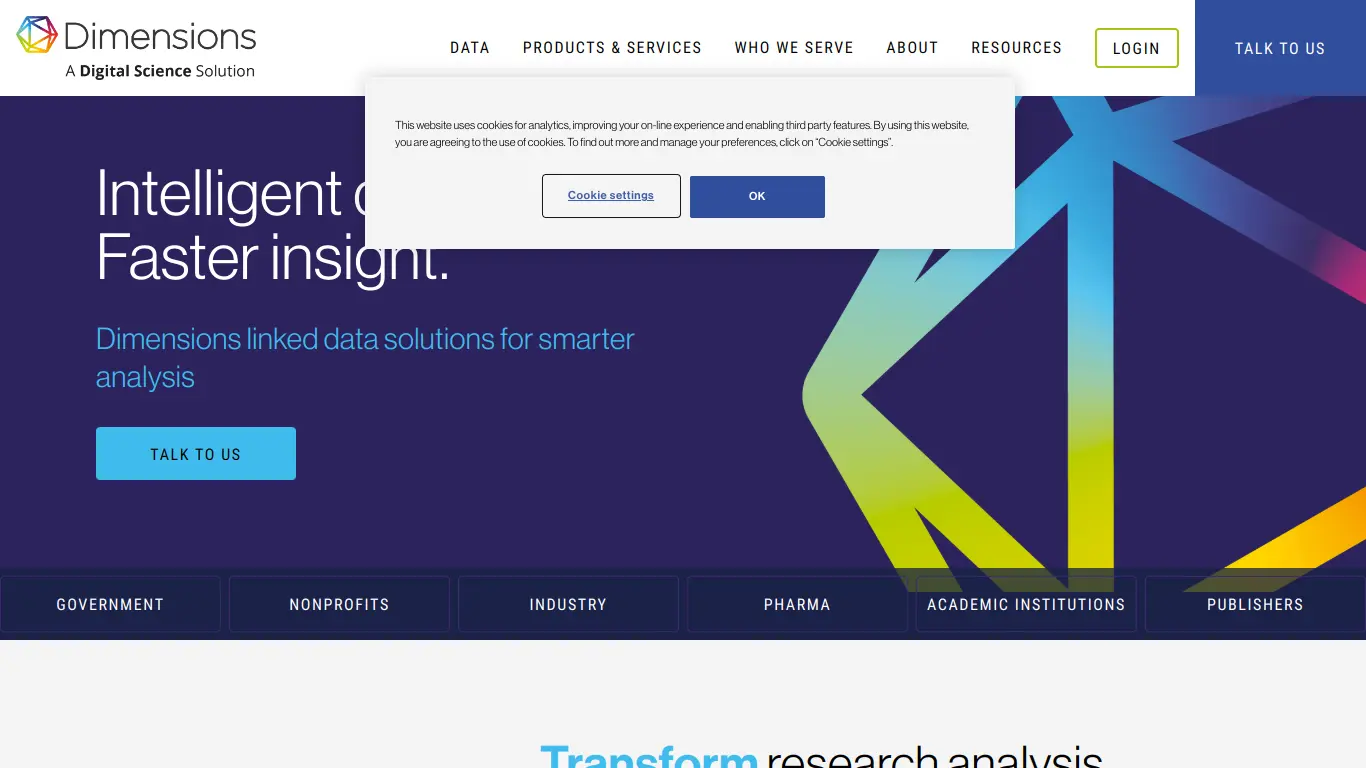Dimensions is an integrated research platform that connects scholarly outputs with real-world impact for researchers, institutions, and funders.
Introduction to Dimensions
Are you drowning in research papers, struggling to find connections between studies, or spending countless hours tracking research impact? If you’re a researcher, academic institution, funder, or publisher, you’ve likely encountered these challenges. Fortunately, in today’s data-driven research landscape, tools like Dimensions are revolutionizing how we discover, analyze, and leverage scholarly information.
What is Dimensions and its Purpose?
Dimensions is a comprehensive research intelligence platform that offers an integrated view of the research landscape. Unlike traditional academic databases, Dimensions connects publications, grants, patents, clinical trials, and policy documents to provide a holistic understanding of research activities and their impact.
Launched by Digital Science in 2018, Dimensions was built to address the limitations of existing research metrics and discovery tools. Its core purpose is to break down silos between different types of research outputs and provide contextual information that helps users understand how research progresses from funding through to real-world application.
The platform indexes over 130 million publications, 6 million grants, 40 million patents, 600,000 clinical trials, and 500,000 policy documents, making it one of the most comprehensive research databases available today.
Who is Dimensions Designed For?
Dimensions serves a diverse audience within the research ecosystem:
🎓 Researchers and Academics: Find relevant literature, identify potential collaborators, track research impact, and discover funding opportunities.
💰 Research Funders: Analyze funding landscapes, track outcomes of funded projects, and inform strategic decision-making.
🏢 Research Organizations and Universities: Benchmark research performance, identify institutional strengths, and showcase achievements.
📚 Publishers: Gain insights into research trends, identify emerging fields, and understand the impact of published works.
🏥 Healthcare Professionals: Access clinical trials and medical research to inform evidence-based practice.
🔍 Industry R&D Teams: Identify innovation opportunities and track patent landscapes.
Getting Started with Dimensions: How to Use It
Getting started with Dimensions is straightforward, with multiple access points depending on your needs:
- Dimensions Free: Visit dimensions.ai and use the search function without creating an account. This gives you basic access to publication data.
- Create a Free Account: Register to save searches, export limited results, and access additional features.
- Dimensions Plus: For organizations requiring advanced analytics, custom reporting, and API access, Dimensions offers subscription-based access.
The basic search interface is intuitive:
- Enter your search terms in the main search box.
- Use filters to narrow results by publication year, research category, source, or open access status.
- Toggle between different content types (publications, grants, clinical trials, patents, etc.).
- Sort results by relevance, date, citations, or Altmetric score.
- Save interesting results to lists or export them in various formats.
Dimensions’ Key Features and Benefits
Core Functionalities of Dimensions
Dimensions stands out from other research databases through its integrated approach and advanced functionalities:
1. Multi-content Database Integration
Dimensions seamlessly connects publications with grants, patents, clinical trials, and policy documents, allowing users to trace the entire research lifecycle from funding to impact.
2. Advanced Analytics and Visualization
The platform offers powerful analytics capabilities, including:
- Citation analysis
- Collaboration networks
- Funding trends
- Research categories analysis
- Geographic distribution of research
3. Contextual Metrics
Unlike traditional citation-only metrics, Dimensions provides contextual indicators:
- Field Citation Ratio (FCR): Citations normalized by research field and time
- Relative Citation Ratio (RCR): Citation impact relative to field average
- Altmetric Attention Score: Online attention from news, social media, and policy documents
4. API Access
For advanced users, Dimensions offers API access to integrate data into custom applications, dashboards, or research management systems.
5. Machine Learning Classification
All content is classified using a machine learning approach into over 334 research categories, enabling more accurate filtering and analysis.
Advantages of Using Dimensions
Using Dimensions provides several distinct advantages over traditional research databases:
✅ Comprehensive Coverage: With over 130 million publications from multiple sources including open access repositories, Dimensions offers broader coverage than many competitors.
✅ Full-text Search: Unlike some databases that only search titles and abstracts, Dimensions indexes full text when available, improving discoverability.
✅ Contextual Connections: The platform reveals connections between different research outputs, helping users understand the bigger picture.
✅ Free Basic Access: While premium features require subscription, the basic search functionality is freely available to anyone.
✅ Up-to-date Data: Dimensions data is updated daily, ensuring access to the latest research.
✅ Transparent Metrics: The methodology behind metrics is clearly explained, avoiding the “black box” approach of some competitors.
Main Use Cases and Applications
Dimensions supports numerous research workflows and applications:
📊 Research Evaluation and Benchmarking
- Compare research output and impact across institutions
- Analyze publication patterns and citation performance
- Benchmark against peer institutions or competitors
🔍 Literature Discovery and Review
- Find relevant publications across disciplines
- Identify seminal papers in a research field
- Track research trends and emerging topics
💡 Strategic Planning
- Identify research strengths and gaps
- Inform hiring decisions based on emerging fields
- Guide institutional research priorities
💰 Funding Analysis
- Discover funding opportunities
- Analyze funding trends and success rates
- Track outcomes of funded research
🔗 Collaboration Identification
- Find potential research partners
- Analyze collaboration networks
- Identify interdisciplinary opportunities
Exploring Dimensions’ Platform and Interface
User Interface and User Experience
Dimensions offers a clean, intuitive interface designed for both casual and power users. The platform follows modern design principles with a focus on clarity and ease of use.
Search Interface:
The main search interface features a prominent search box with advanced filtering options. Results are presented in a clear, scannable format with key metrics immediately visible.
Analytics Dashboard:
For subscribers, the analytics dashboard provides interactive visualizations including:
- Bubble charts of research categories
- Geographic maps of research activity
- Timeline graphs of publication output
- Network visualizations of collaborations
Content Pages:
Individual content pages (for publications, grants, etc.) display comprehensive metadata and contextual information including:
- Citation metrics
- Related documents
- Funding information
- Author affiliations
- Category classifications
The overall user experience is streamlined, with thoughtful touches like hover-over explanations of metrics, keyboard shortcuts for power users, and consistent navigation throughout the platform.
Platform Accessibility
Dimensions is available through multiple channels:
Web Platform: The primary interface at dimensions.ai works on all modern browsers and is responsive for different screen sizes.
Mobile Access: While there isn’t a dedicated mobile app, the web interface is mobile-optimized for on-the-go research.
API Access: Developers and data analysts can access Dimensions data programmatically through REST API or Google BigQuery.
Integration Options: Dimensions data can be integrated with institutional systems through various connectors and widgets.
Language Support: The interface is available in English, with support for multilingual content in search results.
In terms of accessibility standards, Dimensions meets key requirements for users with disabilities, including screen reader compatibility and keyboard navigation options.
Dimensions Pricing and Plans
Subscription Options
Dimensions offers tiered access options to accommodate different user needs:
| Plan | Target Users | Features | Pricing |
|---|---|---|---|
| Dimensions Free | Individual researchers | Basic search, limited exports, publication data | Free |
| Dimensions Plus | Research organizations, universities | Advanced analytics, all content types, unlimited exports | Custom pricing |
| Dimensions Analytics | Research offices, funders | Custom dashboards, benchmarking tools, reporting | Custom pricing |
| Dimensions API | Developers, data teams | Programmatic data access, integration capabilities | Custom pricing |
For enterprise solutions, Dimensions offers customized packages based on:
- Organization size
- Usage requirements
- Integration needs
- Training and support requirements
Pricing for institutional subscriptions is not publicly listed and requires contacting the Dimensions sales team for a customized quote.
Free vs. Paid Features
Understanding what’s available in each tier helps determine which plan best fits your needs:
Free Features:
- Search across 130+ million publications
- Basic filtering options
- View citation counts and Altmetric scores
- Create a personal account to save searches
- Export limited results (CSV, RIS)
Paid Features:
- Access to grants, patents, clinical trials, and policy documents
- Advanced analytics and visualizations
- Custom reporting capabilities
- Unlimited exports in multiple formats
- API access
- Integration with institutional systems
- Benchmarking tools
- Collaboration analysis
- User management for organizations
- Dedicated support and training
For many individual researchers, the free version provides sufficient functionality for literature discovery, while institutions typically require the advanced features available in paid tiers to support strategic decision-making.
Dimensions Reviews and User Feedback
Pros and Cons of Dimensions
Based on user feedback and expert analysis, here’s a balanced view of Dimensions’ strengths and limitations:
Pros:
- 👍 Comprehensive content coverage, particularly for open access publications
- 👍 Intuitive interface with minimal learning curve
- 👍 Contextual connections between different research outputs
- 👍 Sophisticated but understandable metrics
- 👍 Powerful analytics capabilities for institutional users
- 👍 Regular platform updates and feature additions
- 👍 Responsive customer support for paid subscribers
Cons:
- 👎 Some advanced features only available in paid tiers
- 👎 Coverage varies by discipline (stronger in STEM fields than humanities)
- 👎 Can be resource-intensive for complex analytics
- 👎 Learning curve for advanced analytical features
- 👎 Custom pricing model lacks transparency for budget planning
- 👎 Some users report occasional search relevance issues
User Testimonials and Opinions
Feedback from the research community provides valuable insights into real-world experiences with Dimensions:
“As a research librarian, I find Dimensions invaluable for helping faculty understand their research impact beyond just citation counts. The visualizations make complex data accessible even to those without bibliometric expertise.” – University Research Librarian
“The integration of publications with grants and patents gives me a complete picture of research development in my field. I’ve discovered collaboration opportunities I would have missed using traditional databases.” – Biomedical Researcher
“Our research office uses Dimensions to benchmark our institution against peers and identify emerging research strengths. The data has directly informed our strategic planning and resource allocation.” – University Research Director
“While I appreciate the free access, I sometimes find the search results less precise than specialized databases in my field. However, for interdisciplinary work, it’s become my go-to resource.” – Social Sciences Professor
“The API access has allowed us to build custom dashboards that align with our institutional KPIs. The data quality and regular updates make it reliable for decision-making.” – Research Analytics Manager
Online review platforms show generally positive ratings, with Dimensions typically receiving 4+ out of 5 stars from users. Common themes in positive reviews include ease of use and comprehensive coverage, while critical reviews most often mention pricing concerns and discipline-specific coverage gaps.
Dimensions Company and Background Information
About the Company Behind Dimensions
Dimensions is developed and maintained by Digital Science, a technology company focused on making research more efficient through better use of technology and data.
Company History:
Digital Science was founded in 2010 as a division of Macmillan Publishers and later became an independent company. The company has built a portfolio of research tools including Altmetric, Figshare, Symplectic, and Overleaf.
Dimensions itself launched in January 2018, representing a significant investment in reimagining research discovery and analytics. The platform was developed in collaboration with over 100 research institutions worldwide to ensure it addressed real needs in the research community.
Leadership and Expertise:
The Dimensions team includes experts in bibliometrics, data science, and research evaluation. Key leadership includes:
- Christian Herzog (CEO of the Dimensions group)
- Daniel Hook (CEO of Digital Science)
- Catherine Williams (COO of Dimensions)
Company Values and Mission:
Digital Science describes its mission as “supporting the research community to work smarter and discover more.” The development of Dimensions aligns with this mission by making research data more accessible, connected, and meaningful.
Partnerships and Integrations:
Dimensions has established partnerships with numerous organizations including:
- Research institutions and universities
- Publishers including Springer Nature, Wiley, and IEEE
- Open access initiatives like ORCID and CrossRef
- Research assessment programs including REF and ERA
These partnerships enhance the platform’s data coverage and ensure its alignment with community standards and practices.
Dimensions Alternatives and Competitors
Top Dimensions Alternatives in the Market
Several platforms compete with Dimensions in the research intelligence and discovery space:
Web of Science
Web of Science is one of the oldest and most established citation databases, owned by Clarivate Analytics. It offers selective journal coverage with a focus on high-impact publications.
Scopus
Scopus is Elsevier’s abstract and citation database covering peer-reviewed literature, books, and conference proceedings. It offers robust analytics and author profiles.
Google Scholar
Google Scholar provides a free search engine for scholarly literature across disciplines and sources. It lacks advanced analytics but offers excellent coverage and accessibility.
Lens.org
Lens.org is a free, open platform integrating scholarly works, patents, and biological sequences. It emphasizes open data and reproducible analytics.
Microsoft Academic
Microsoft Academic was a competitor but was discontinued in 2021, with some features integrated into other Microsoft products.
Semantic Scholar
Semantic Scholar from the Allen Institute for AI uses machine learning to improve research discovery, with a focus on computer science and biomedical literature.
Dimensions vs. Competitors: A Comparative Analysis
How does Dimensions stack up against its main competitors? This comparison highlights key differences:
| Feature | Dimensions | Web of Science | Scopus | Google Scholar |
|---|---|---|---|---|
| Content Coverage | 130M+ publications, grants, patents, clinical trials, policy documents | 90M+ records, selective journal focus | 80M+ records from 24,600+ journals | Not disclosed, estimated 160M+ |
| Access Model | Free basic access, subscription for advanced features | Subscription only | Subscription only | Free |
| Unique Strength | Research connections across content types | Long-standing citation data | Author profiles and metrics | Simple interface, broad coverage |
| Analytics | Comprehensive analytics and visualizations | Advanced but traditional analytics | Strong institutional analytics | Limited analytics |
| Cost | Free to $$$ (custom pricing) | $$$ | $$$ | Free |
| API Access | Yes (paid) | Yes (paid) | Yes (paid) | Limited |
| Updated | Daily | Weekly | Daily to weekly | Varies |
Dimensions’ Competitive Edge:
- More comprehensive integration of different research outputs
- More accessible pricing model with free tier
- More frequent updates
- Broader coverage of open access content
Areas Where Competitors Excel:
- Web of Science: Longer historical data and selective journal coverage
- Scopus: Author profile features and institutional tools
- Google Scholar: Simplicity and accessibility
- Lens.org: Open data approach and patent integration
Dimensions Website Traffic and Analytics
Website Visit Over Time
Dimensions has shown consistent growth in website traffic since its launch in 2018, reflecting increasing adoption within the research community.
Based on third-party analytics data:
📈 Monthly Visitors: Approximately 1.2-1.5 million unique visitors per month
📈 Page Views: Around 8-10 million monthly page views
📈 Average Session Duration: 7-9 minutes
📈 Year-over-Year Growth: Approximately 15-20% increase in traffic
Traffic tends to follow academic calendars, with noticeable dips during summer months and December holidays, aligning with typical research activity patterns.
Geographical Distribution of Users
Dimensions has a truly global user base, with significant traffic from countries with large research outputs:
🌎 Top User Countries:
- United States (25-30%)
- United Kingdom (8-10%)
- China (7-9%)
- Germany (5-7%)
- Japan (4-6%)
- Australia (4-5%)
- Canada (3-5%)
- India (3-4%)
- France (2-3%)
- Brazil (2-3%)
The platform shows particularly strong adoption in regions with well-developed research infrastructure, but is gaining traction in emerging research economies as well.
Main Traffic Sources
Understanding how users find Dimensions provides insight into its place in the research workflow:
🔄 Traffic Sources:
- Direct Traffic: 40-45% (indicating strong brand recognition)
- Organic Search: 30-35% (primarily Google searches for research terms)
- Referrals: 15-20% (from university library portals, research guides, etc.)
- Social Media: 3-5% (primarily Twitter/X and LinkedIn)
- Email: 2-3% (newsletters and alerts)
The high percentage of direct traffic suggests Dimensions has established itself as a bookmark-worthy resource for regular users, while strong organic search performance indicates its relevance to research-related queries.
Frequently Asked Questions about Dimensions (FAQs)
General Questions about Dimensions
Q: What makes Dimensions different from other research databases?
A: Dimensions uniquely connects publications, grants, patents, clinical trials, and policy documents to provide a complete view of the research landscape. This integration helps users understand how research develops from funding through to real-world impact.
Q: How comprehensive is Dimensions’ coverage?
A: Dimensions indexes over 130 million publications, 6 million grants, 40 million patents, 600,000 clinical trials, and 500,000 policy documents. Coverage is strongest in STEM fields but includes all research disciplines.
Q: Is Dimensions suitable for humanities research?
A: Yes, although coverage is more comprehensive for STEM disciplines, Dimensions includes humanities content and continues to expand in this area. The platform’s categorization system includes dedicated humanities classifications.
Q: How often is Dimensions updated?
A: The database is updated daily with new publications, grants, patents, clinical trials, and policy documents to ensure users have access to the latest research outputs.
Feature Specific Questions
Q: How does Dimensions calculate its Field Citation Ratio (FCR)?
A: The FCR normalizes citation counts based on the research field and publication year, allowing for fair comparison across different disciplines and time periods. The metric compares a publication’s citations to the average for similar publications.
Q: Can I save my searches and results in Dimensions?
A: Yes, by creating a free account, you can save searches, create lists of publications, and set up email alerts for new content matching your criteria.
Q: Does Dimensions provide full-text access to publications?
A: Dimensions itself doesn’t host full texts but links to publisher sites and open access repositories when available. For open access content, direct links to PDF files are often provided.
Q: Can I export results from Dimensions?
A: Yes. The free version allows limited exports in formats like CSV and RIS. Paid subscriptions enable unlimited exports and additional formats suitable for reference management software.
Pricing and Subscription FAQs
Q: Is Dimensions completely free to use?
A: Dimensions offers a free version with basic search functionality across publications. Advanced features, analytics, and access to grants, patents, clinical trials, and policy documents require a paid subscription.
Q: How much does a Dimensions Plus subscription cost?
A: Dimensions uses custom pricing based on organization size, usage requirements, and selected features. Contact the sales team for a quote tailored to your needs.
Q: Do you offer educational discounts?
A: Yes, special pricing is available for academic institutions, with additional considerations for smaller colleges and universities in developing regions.
Q: Can I try Dimensions Plus before purchasing?
A: Yes, Dimensions offers trial access to its premium features for qualified organizations. Contact the sales team to arrange a demonstration and trial period.
Support and Help FAQs
Q: Is training available for new users?
A: Yes, Dimensions offers training sessions for institutional subscribers, along with online tutorials, webinars, and documentation for all users.
Q: How can I get technical support for Dimensions?
A: Free users can access online documentation and FAQs. Paid subscribers receive dedicated technical support via email and phone, with response times typically within 24 hours.
Q: Does Dimensions offer API documentation?
A: Yes, comprehensive API documentation is available for developers using the Dimensions API, including sample code, use cases, and best practices.
Q: Where can I suggest new features for Dimensions?
A: Dimensions welcomes feedback through its support portal. The platform development is guided by user input, with regular updates incorporating requested features.
Conclusion: Is Dimensions Worth It?
Summary of Dimensions’ Strengths and Weaknesses
After thoroughly exploring Dimensions, let’s summarize its key strengths and weaknesses to help you decide if it’s the right tool for your research needs:
Strengths:
- 🌟 Integrated view of the entire research lifecycle, connecting publications with grants, patents, and real-world impacts
- 🌟 Comprehensive coverage, especially of open access content
- 🌟 Intuitive interface requiring minimal training
- 🌟 Powerful analytics capabilities for institutional users
- 🌟 Contextual metrics that provide more meaningful insights than raw citation counts
- 🌟 Free tier that provides genuine value for individual researchers
- 🌟 Regular platform updates that respond to user feedback
Weaknesses:
- ⚠️ Full functionality requires a paid subscription
- ⚠️ Custom pricing model lacks transparency for budgeting
- ⚠️ Coverage still stronger in STEM fields than humanities
- ⚠️ Advanced analytics features have a learning curve
- ⚠️ Some users report search relevance could be improved
- ⚠️ Institutional implementation requires significant investment in training and integration
Final Recommendation and Verdict
For Individual Researchers:
If you’re an individual researcher looking to enhance your literature discovery process and gain insights into research impact, Dimensions’ free tier offers exceptional value. The platform’s intuitive interface and comprehensive publication coverage make it a worthy addition to your research toolkit, complementing rather than replacing specialized databases in your field.
For Academic Institutions:
For universities and research organizations seeking to understand their research performance and make data-driven strategic decisions, Dimensions Plus provides capabilities that justify its cost. The platform’s integrated approach to research intelligence offers unique insights that traditional citation databases cannot match. The investment pays off in improved strategic planning, better funding decisions, and more effective research assessment.
For Funders and Publishers:
If you’re a research funder or publisher, Dimensions offers invaluable insights into research trends, impact pathways, and emerging fields. The platform’s ability to connect funding with outputs and impacts creates a powerful tool for demonstrating value and informing future strategies.
Final Verdict:
Dimensions represents a significant advancement in research intelligence platforms, successfully addressing many limitations of traditional citation databases. Its approach of connecting different research outputs provides context that isolated metrics cannot, while its tiered access model makes it accessible to users with different needs and resources.
For most users—whether individuals or organizations—Dimensions offers sufficient value to warrant adoption, either as a free tool for basic research discovery or as a comprehensive research intelligence platform. As the research landscape continues to evolve, Dimensions’ regular updates and responsive development approach position it well to remain a valuable resource for the global research community.




















